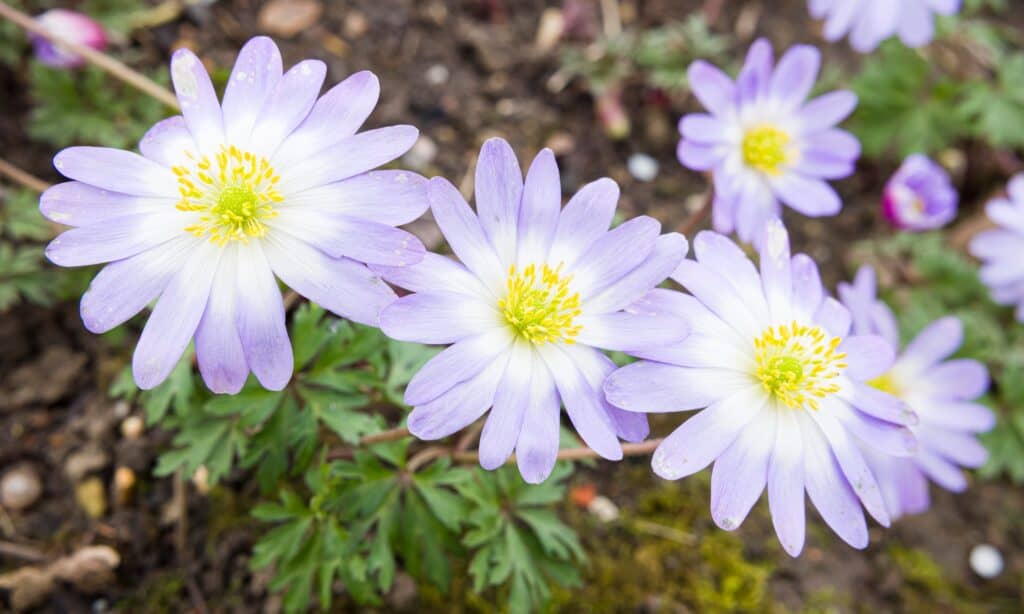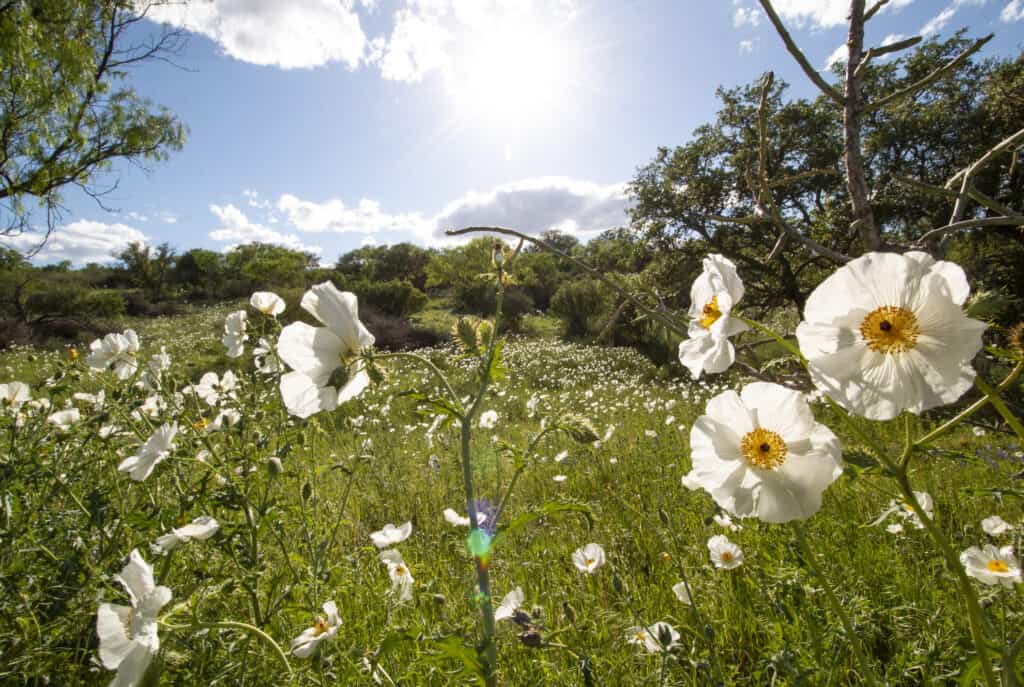One search online for ‘anemone vs poppy’ and you may be left with even more questions than answers. First, it’s good to know they are not the same plant. While they both produce vibrant flowers, they come from different families. So, why are they frequently confused with each other?
Are you ready to learn more about the differences between an anemone vs. a poppy plant? Through this article, we will discuss things like scientific classification, description, uses, and origin. In the end, we will also discuss some fun facts about both flowering plants.
Comparing Anemone vs. Poppy

| Anemone | Poppy | |
|---|---|---|
| Scientific Classification | Anemone is a genus of flowering plants. It is part of the Ranunculaceae family (the buttercup family). | Poppies are flowering and herbaceous plants in the subfamily Papaveroideae of the family Papaveraceae. |
| Description | Perennial flowers with basal leaves and long leaf stems that hold beautiful flowers. On each long stem, there are bunches of leaves. There are 120 species in this genus. | Depending on the variety, they are herbaceous annual, biennial, or short-lived perennial plants. They are tall flowers, easily passing 3 feet tall. The flowers are vibrant and have 4 to 6 petals each. There are over 120 species of poppies. |
| Uses | Decorative plant with medicinal benefits including anti-inflammatory and immunomodulatory properties. | Decorative plants with many uses. Poppies can be made into an oil for cooking and are used as an ingredient in cakes, bread, dressings, and dried latex. |
| Origin and Growing Preferences | Native to subtropical regions except for three places, Australia, Antartica, and New Zealand. Grows in USDA Zones 3-10 depending on the species. | The origin is heavily debated. Thought to be the Sumerian people who traded these plants along the silk road. Grows in USDA Zones 3-10 depending on the species. |
Key Differences Between Anemone vs. Poppy
Are you ready to discover the key differences between anemone and poppy plants? they may surprise you! While these flowers grow and thrive in the same USDA zones, that is basically where the majority of their similarities end.
Anemone vs. Poppy: Scientific Classification

Another common name for anemones is windflowers.
©iStock.com/PaulMaguire
Anemone is a genus of flowering plants. It belongs to the Ranunculaceae family. A common name for flowers in the genus is windflowers. There are over 2,000 species of flowering plants in the family including Christmas roses and globeflowers. Poppy plants, on the other hand, are flowering species within the Papaver genus and Papaveraceae family. Other species in the same family are the climbing bleeding-heart, golden eardrops, and the tulip poppy.
Anemone vs. Poppy: Description
No one description of either a poppy or anemone plant fits all. Since anemone is a genus, it includes hundreds of flowering plants. Anemone flowers are perennials with short basal leaves and long leaf stems that grow upright. Some flowers develop in a single or double bloom. The flowers hold 5 to 6 petals and vary in color. You can find blue, pink, yellow, and white windflowers.
Poppy flowers have a unique look. The flowers have four to six petals with numerous stamens. The petals open up and sometimes droop and at least two sepals fall when they unfold. Poppy leaves are either lobed or dissected and produce a milky sap. The flowers range in size and color. Some are smaller than a quarter, while others are larger than a plate. While the most common poppy flower in the media is red, it can also be purple, blue, white, yellow, and orange.
Anemone vs. Poppy: Uses
While some research has shown that anemone plants can be used to treat cancer, nothing is approved. It is widely used in some countries as a herb to treat inflammation because of its anti-inflammatory and antioxidant properties. Please note: A-Z Animals does not recommend plants or herbs for medicinal or health use. We present the following information for academic and historical purposes only. Often it is just grown as a decorative plant.
Poppy flowers, on the other hand, have a lot of uses, especially in the kitchen. You can make an oil out of them for cakes, cookies, and bread. Poppy seeds are very common in dressings, chicken dishes, and muffin recipes. Some companies use poppy oil in cough drops and historically it’s been used as a pain reliever and muscle smoother added to cosmetics. However, you should keep poppy seeds and flowers away from dogs since they can suffer from poppy seed poisoning.
Anemone vs Poppy: Origin and Growing Preferences

The sunlight requirement for poppy flowers to grow is quite high.
©iStock.com/David P. Hilss
Poppy flowers grow everywhere and have a long history. The origin is heavily debated, but the first description of a wild poppy flower is from the ancient land of Sumer. You can find them growing in the wild in the U.S, Belgium, and China. They also grow best in USDA zones 3-10 and need full sun with fertile soil. When you grow these beautiful flowers, it’s best to space them 12 to 24 inches apart so their root systems have space to develop. Poppy seeds won’t grow well if you plant them deeply since they require a lot of light.
Anemone plants are native almost everywhere, but they may have originated from Japan. This is often debated though. They grow well in warm and subtropical regions of the world. Before they evolved, the first plants didn’t flower so beautifully or fragrantly. They grow best in USDA zones 3-10 and are hardy to heat and frost depending on the species. Anemone plants require partial shade with sun and well-draining soil. The best part is you can grow these plants in containers.
What is a Poppy Anemone?

Poppy anemone flowers are actually anemones.
©iStock.com/yuelan
The reason people confuse anemone with poppy is because they have two names that don’t belong to the same family. It might surprise you to know that the poppy anemone flower is actually an anemone and not a poppy, confusing right? Another nickname for this plant is the Spanish marigold. It’s a short plant that rarely grows past a foot tall. The flowers bloom in spring between April and June and have a whorl of small leaves below the flower. The flower is usually red, but some varieties grow white or blue petals.
Poppy anemone flowers pop because they are black in the center, resembling buttons. Each flower produces about 200 to 300 seeds. This plant grows well in many places like Greece, Italy, Iran, and Syria. It was brought to England in the 1500s, and shortly after France and Italy cultivated the flowers creating cultivars with larger blooms. If you want to grow a poppy anemone flower, it thrives in USDA zones 7–10.
Anemone Fun Facts
There are so many things to learn about this genus of beautiful flowering plants. Listed below are some fun facts.
- A common nickname for wild anemones is “wind flowers”.
- Some species bloom in the summer and fall as opposed to spring.
- Its name has Greek origin and means wind.
- In China and Egypt, these flowers symbolize death or illness. It is seen as a negative sign.
- Violet anemone plants are often used in wedding bouquets to add a pop of color.
Poppy Fun Facts
Poppy flowers are well-known and very interesting. Maybe some of these fun facts will surprise you!
- After the fighting had ceased in World War I, thousands of bright red poppies grew on Flanders fields.
- Poppies produce a milky white latex needed to make morphine.
- Poppies are so old there are paintings from ancient Egypt depicting these beautiful flowers.
- A lot of popular literature, like the Iliad, references poppy flowers.
- Some poppy plants grow over 3 feet tall and 6 inches wide.
Up Next:
5 Best Perennial Flowers for Texas
The photo featured at the top of this post is © iStock.com/PaulMaguire
Sources
- National Library of Medicine (1970) ncbi.nlm.nih.gov/pmc/articles/PMC5343163/#:~:text=Various medicinal compounds have been,%2C antioxidant%2C and antimicrobial activities.
Thank you for reading! Have some feedback for us? Contact the AZ Animals editorial team.






